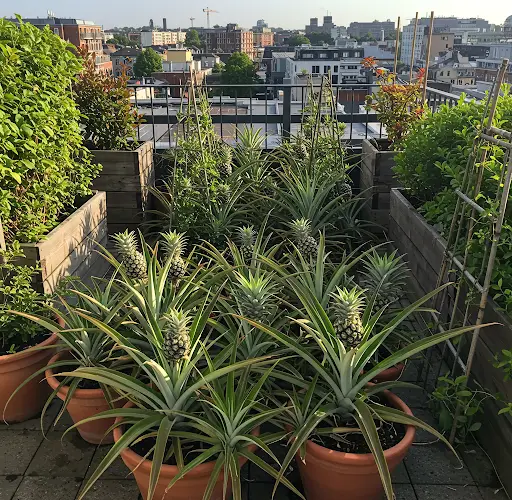If you’ve ever enjoyed a sweet, juicy pineapple, don’t throw away the crown! With the right technique, you can turn pineapple tops into a thriving, productive garden—without spending a single cent on seeds or seedlings. This simple yet effective method uses everyday kitchen scraps to grow healthy, fruiting plants that can thrive in your backyard or even in containers.
Pineapples are surprisingly resilient and can be grown in a wide variety of climates, especially in tropical and subtropical areas. Even in cooler regions, they can be started indoors and moved outside during warm seasons.
Here’s a step-by-step guide to starting your own zero-cost pineapple garden using only pineapple tops.
Step 1: Choose the Right Pineapple
Start with a healthy, ripe pineapple. Look for the following signs:
-
Firm, green leaves with no signs of rot or browning.
-
A golden-colored body with a sweet aroma.
-
No mold around the crown or base.
The fresher the pineapple, the better the chance the crown will root successfully.
Step 2: Prepare the Pineapple Top
Once you’ve enjoyed the fruit, you’ll be left with the leafy crown. Here’s how to prepare it for planting:
-
Twist or cut off the crown from the fruit.
-
Remove a few of the lower leaves (about 1–2 inches) to expose the stem.
-
Let it dry: Place the crown in a dry, shaded spot for 1–2 days to allow the cut end to heal. This helps prevent rotting when planted.
Optional: To encourage faster rooting, you can place the dried crown in a glass of water just deep enough to cover the base. Change the water every 2–3 days until roots appear (usually within 1–2 weeks).
Step 3: Planting Your Pineapple Crown
Once the crown has dried (or developed roots in water), it’s ready for planting.
What you need:
-
A container with drainage holes or a garden bed with loose, well-draining soil.
-
A soil mix of sandy loam or potting mix mixed with compost.
-
A sunny spot, as pineapples love warmth and light.
Planting steps:
-
Dig a small hole and insert the base of the crown into the soil.
-
Press the soil firmly around the base for stability.
-
Water lightly after planting.
Keep the plant in a bright, warm area where it receives at least 6–8 hours of sunlight daily.
Step 4: Watering and Maintenance
Pineapples are drought-tolerant but appreciate regular moisture, especially while young.
-
Water once or twice a week during dry periods. Let the soil dry slightly between waterings.
-
Avoid overwatering. Pineapple roots are shallow and can rot in soggy soil.
-
In hot, dry climates, you can occasionally mist the leaves to mimic a humid environment.
Add organic compost or diluted liquid fertilizer (like seaweed extract or compost tea) once a month to boost growth, especially after the first few months.
Step 5: Patience Pays Off – The Growth Timeline
Pineapple plants grow slowly at first, but with proper care, they’ll reward you with sweet, homegrown fruit.
Typical timeline:
-
First 3–6 months – Root development and leaf growth.
-
6–12 months – The plant grows larger, forming a dense rosette.
-
12–18 months – Under ideal conditions, a central flower spike (called the inflorescence) forms.
-
18–24 months – The flower develops into a fruit. Once the fruit turns golden and fragrant, it’s ready to harvest.
Note: Growing time may vary depending on your climate, soil, and care.
Step 6: Harvesting and Propagation
When the pineapple is fully ripe, twist or cut the fruit from the stalk. You’ll notice the familiar sweet aroma and golden skin.
But the journey doesn’t end there—each mature pineapple plant can produce pups or suckers, which are small shoots that emerge from the base or sides of the plant.
To expand your garden:
-
Wait until pups are 6–8 inches tall.
-
Gently separate them from the mother plant.
-
Replant the pups just like the original crown.
This method allows you to build a self-sustaining pineapple garden from a single fruit—without ever buying another plant again.
Extra Tips for Success
-
Containers work great if you have limited space. Choose large pots (at least 5 gallons) for best results.
-
Mulch around the base to retain moisture and suppress weeds.
-
If your climate is too cold for outdoor growing, move the pots indoors during winter or grow in a greenhouse.
-
Protect from frost—pineapples cannot tolerate freezing temperatures.
Final Thoughts
Creating a pineapple garden from tops is not only cost-free but also deeply satisfying. With a bit of patience and care, you can enjoy fresh, sweet pineapples grown entirely from kitchen scraps. This sustainable, budget-friendly method is perfect for home gardeners of all experience levels.
So next time you eat a pineapple, don’t toss the crown—turn it into the beginning of your very own tropical garden.



